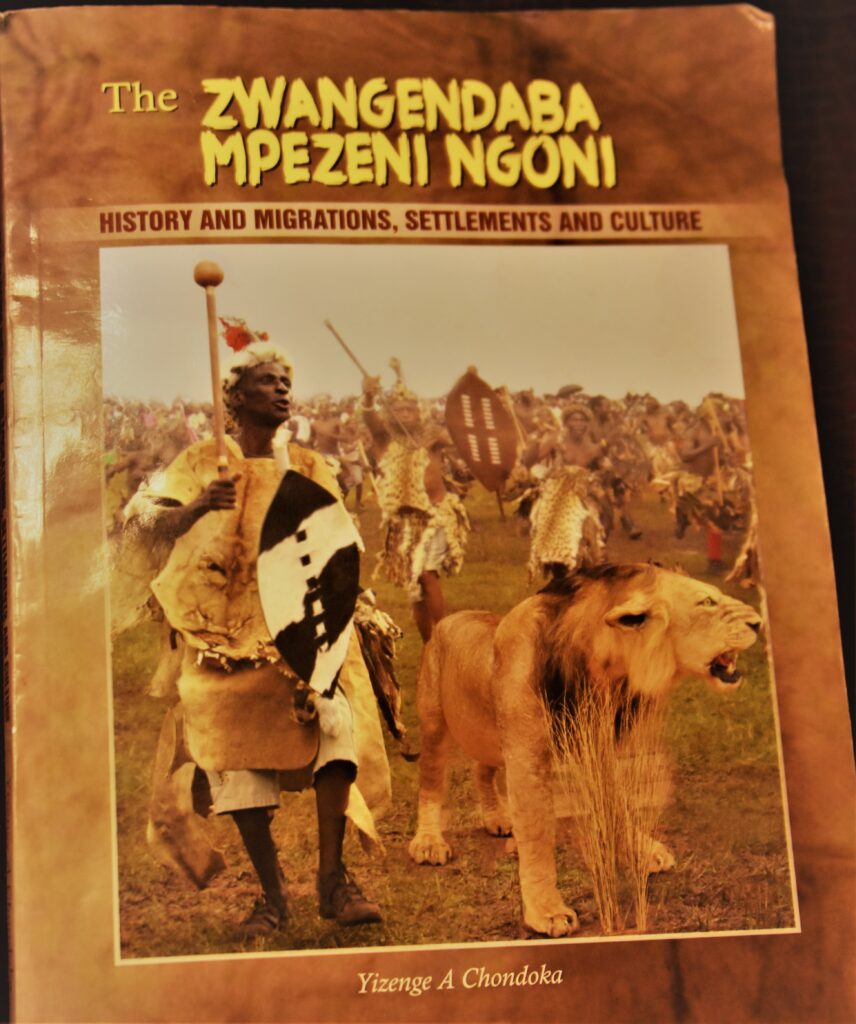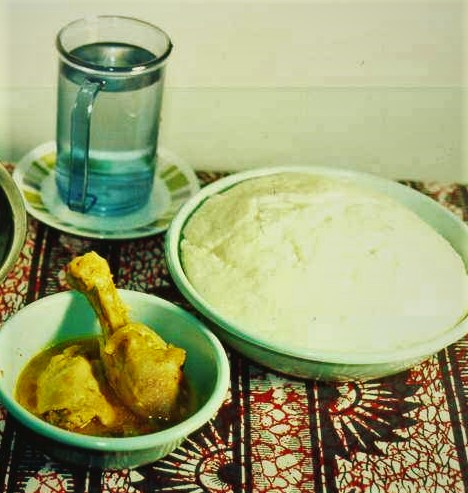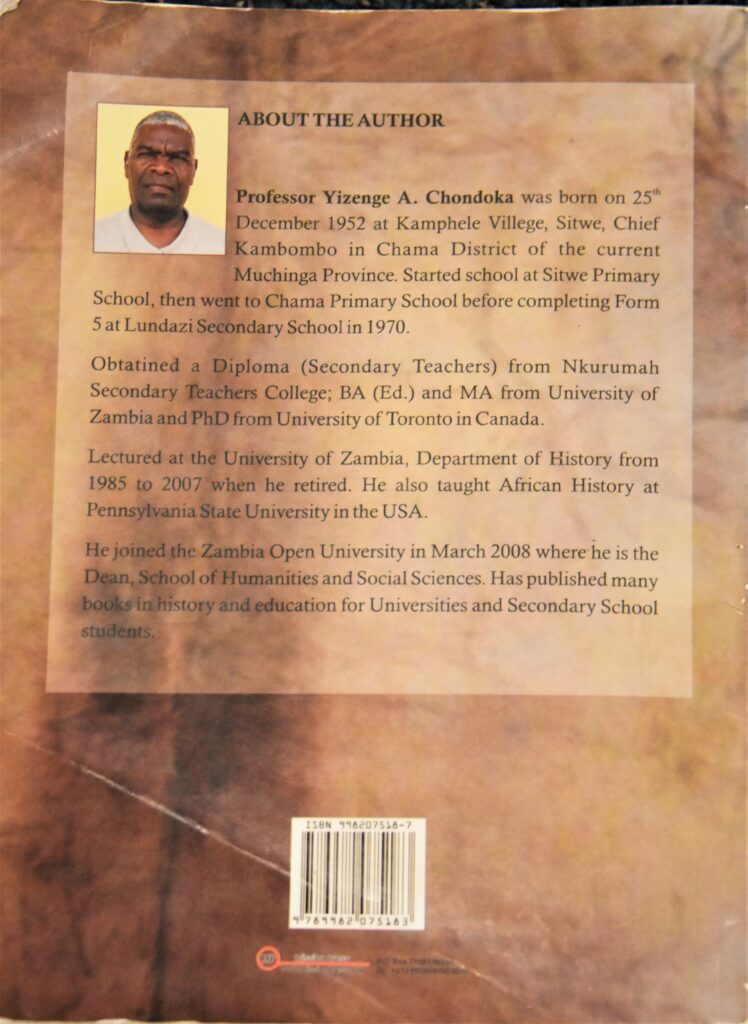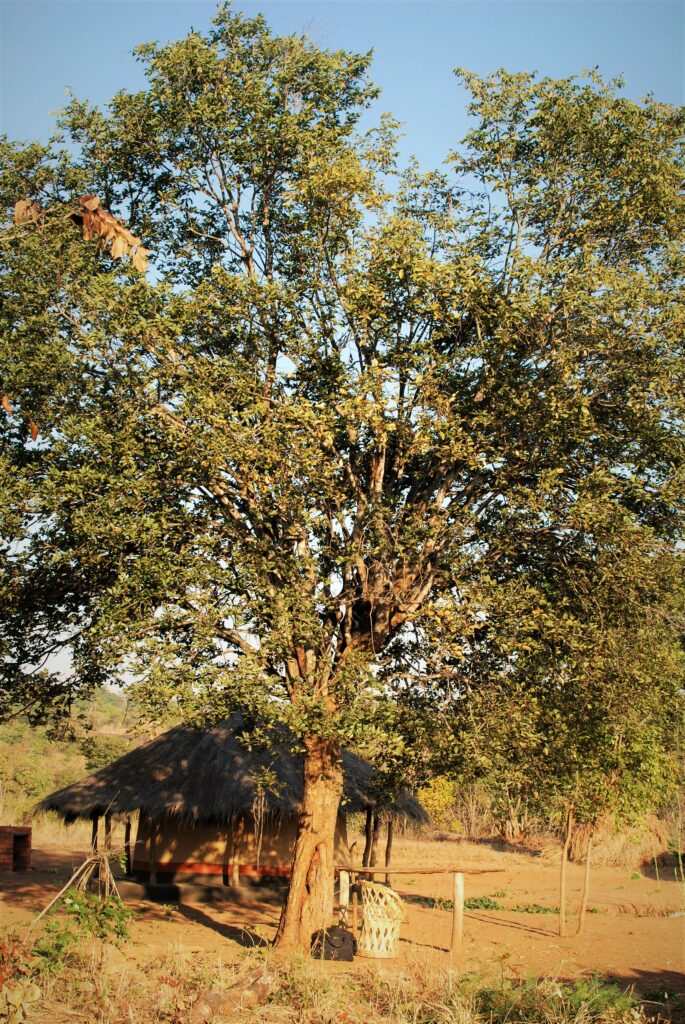Yizenge Chondoka, The Zwangendaba Mpezeni Ngoni: History and Migrations, Settlements and Culture, Lusaka, Academic Press, 2017, 148 pages, Hardcover, $32.00 (K411.00)
BOOK REVIEW – in Memory of Dr Yizenge Chondoka
by
Mwizenge S. Tembo, Ph. D
Professor of Sociology
Introduction
At dawn on June 23rd 2019, I boarded a bus in Lusaka. My destination was Lundazi in the rural remote Eastern Province of Zambia. I was anxious and excited to arrive at the bus station at 15hours or 3:00pm Zambian time. Before my final leg of the journey of a 45-minute minibus ride to visit my relatives to eat nshima with chicken, in my home village near Boyole in the North-Western part of the Lundazi District, I was to meet a man who was going to hand me a special gift.

As soon as I stepped out of the bus, the short man stepped forward. He was grinning ear to ear, had bright eyes with some grey hair. I finally met Mr. Frackson Bota. We shook and pumped hands as we excitedly greeted each other and talked with a mix or English and Tumbuka as we multilingual Zambians do.
“Here is Dr. Chodoka’s book,” Mr. Bota said amid our laughter and excitement.
This is how I finally got possession of a precious gift from the late Dr. Yizenge A. Chondoka’s book: The Zwangendaba Mpezeni Ngoni. He passed awayin May 2017 leaving instructions to Mr. Bota to hand me a copy of the book because of my dedication to and passion for Zambian and African culture. I was flattered to see the message Mr. Bota inscribed in the book.
Whenever I have a book that I know I will enjoy, I don’t read it all at once. I could have read the 13 Chapters and 148 pages in one evening. But like a delicious meal of nshima with best ndiyo, umunani, dende or relish, I wanted to eat it slowly over a few days enjoying a few pages each day while I was in the village sitting under my favorite shady Msoro tree. It is tempting to tell the reader everything that is in the book. But then what are you going to be left to read when you buy the book? There are so many things I found good about the book. I will summarize four of them; who was Nsingo? The Great Shaka King; Mfecane Wars and the debunking of the white or European bogus Hamitic hypothesis, the Bemba-Ngoni Wars, and the significance of Zwangendaba-Ngoni.

Who was Nsingo?
When I attended Chizongwe Secondary School in Chipata from 1967 to 1971, there were four Halls of Residence; Aggrey, Muleya, Skeva Soko, and Nsingo House. I had heard that Nsingo was a hero in the then Fort Jameson in the late 1800s and now Chipata area. To my great joy, Chapter 12 of the book says Nsingo was a great hero and a martyr in the 1897-8 Anglo-Ngoni War in the Mpezeni Kingdom. You can learn the details of that war in the book.
Shaka Zulu and the Bogus Hamitic Hypothesis
Shaka Zulu and how he ruthlessly ruled and expanded the Zulu Empire is one of the most influential leaders of all time in history. He instigated the Mfecane Wars or wars of chaos and disorder from 1818 to 1828 which affected the entire Southern Africa; Zimbabwe, Botswana, Mozambique, Zambia, Malawi up to Southern Tanzania. To understand the falsehood or bogusness that is the European or white Hamitic Hypothesis, you have to understand its origins. In 1758 a Swedish biologist came up with biological classifications of humans. Europeans eventually came up with racial classifications in the 1890s that classified humans into Caucasians, Mongloid and Negroid wrongly creating racism; with Negroid (blacks;Africans) being the most inferior and Caucasians (Whites) being most superior. The Hamitic Hypothesis is the popular idea which Europeans spread all over the world that Africans could not come up with anything useful or intelligent on their own; there had always somehow had to be a European or White influence.

Europeans used the Hamitic Hypothesis in history books to claim that Shaka Zulu was influenced by the Dutch, the British, or the Portuguese because Shaka Zulu could not have created such a powerful empire on his own being of course black and an African. Yizenge Chondoka thoroughly debunks the Hamitic Hypothesis.
“However, recent historical researchers in South Africa have proved beyond doubt that the theory of White Inspiration is false. There was no outside influence to the rise of the Zulu state…..Finally using the available evidence, it is safe to conclude that this theory is indeed false. It was coined to match its counterpart: Hermitic hypothesis, which basically states that anything good on the Continent of Africa was brought by outsiders, the white people.”(Chondoka, 2017: 8-9)
The Ngoni-Bemba Wars
The Ngoni and Bemba peoples fought many wars when they encountered each other in the Northern province of Zambia. Historians on both sides have tried to determine who won the wars. About this dispute, Chondoka says: “The book is dedicated to the Bemba who have reluctantly ‘agreed’ with the Ngoni that in the Bemba-Ngoni war none of the two was ‘defeated’. On this point, it is better to agree to disagree to avoid unnecessary arguments that can lead to High Blood Pressure for one group.”(Dedication, p. ii)

Zwangendaba 1815-1848
Another looming and towering figure was the influential Ngoni leader Zwangendaba. He led the Ngoni for 30 years as they moved in the Southern African region conquering many other peoples along the way and incorporating them into the Ngoni Kingdom. Some of his decisions, his death and succession were controversial. This is often the case with larger than life leaders. My father is Ngoni and my late mother was Tumbuka. That intertribal marriage was a Ngoni influence among the Tumbuka in Eastern Zambia and Northern Malawi.
Conclusion
I highly recommend this book if you are among the 17 million Zambians at home and abroad. If you come from the Southern Africa region, there is a chance that Shaka Zulu and the Ngoni influenced your ancestors, language, and culture. I took history in Secondary School and in Universities. That history is heavily Eurocentric some of which Chondoka debunks. The book both taught me and confirmed that as Zambians we created our own history, which we never read, in the Eurocentric history which is often wrongly projected as the only and most accurate history.